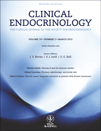Acromegaly surgery in Manchester revisited – The impact of reducing surgeon numbers and the 2010 consensus guidelines for disease remission
Summary
Introduction Surgical remission rates for acromegaly vary and are dependent on the tumour morphology, biochemical definition of disease remission and surgical expertise. A previous report from the Manchester region in 1998 reported an overall surgical remission rate of 27% using accepted criteria for biochemical remission at the time. The establishment of the 2010 Consensus guidelines further tightens biochemical criteria for remission. This report aims to assess the impact of establishing a specialist pituitary surgery service in Manchester in 2005, with reduced surgeon numbers on the remission rates for acromegaly surgery.
Methods Patients with acromegaly undergoing first time endoscopic transsphenoidal surgery between 2005 and 2010 were studied. Surgery was performed by a single surgeon. Review of a prospectively collected acromegaly surgery database was performed with documentation of pre- and postoperative biochemical tests [oral glucose tolerance test (oGTT) and IGF-1], as well as clinical, pathological and radiological data. Definition of disease remission was according to the 2010 Consensus criteria (GH nadir <0·4 μg/l following an oGTT and normalized population matched IGF-1).
Results There were 43 consecutive patients with acromegaly, with 13 (30%) microadenomas and 12 (28%) invasive adenomas. Overall, surgical remission was achieved in 29 (67%) patients. The remission rates were similar between micro (77%), macro (63%) and giant (67%) adenomas. There were nonsignificant trends towards higher remission rates for noninvasive tumours compared with invasive tumours (74%vs 50%) and for patients with a preoperative GH nadir <10 μg/l (73%vs 54%) and IGF-1 standard deviation score <15 (72%vs 54%).
Conclusions Remission rates for acromegaly surgery have improved following establishment of a specialist surgical service, with a reduction in surgeon numbers. Endoscopic trans-sphenoidal surgery remains an effective first-line treatment for achieving biochemical remission in acromegaly, despite the introduction of the more stringent 2010 consensus guidelines.




